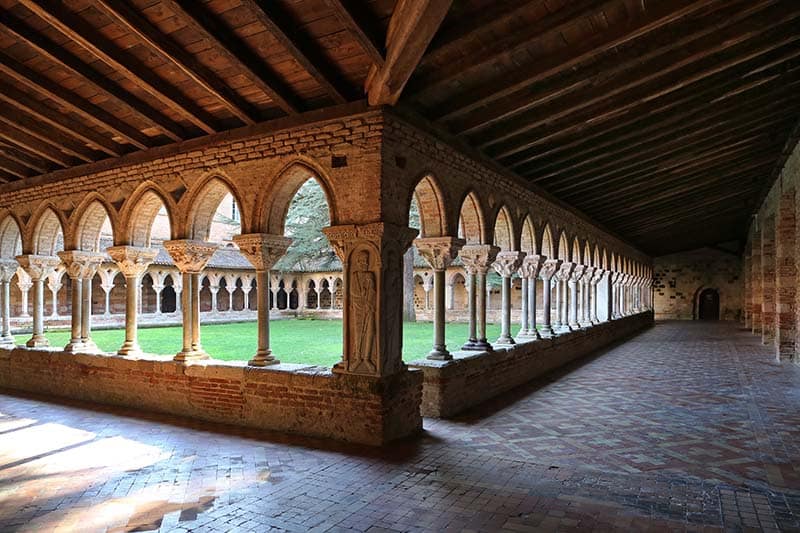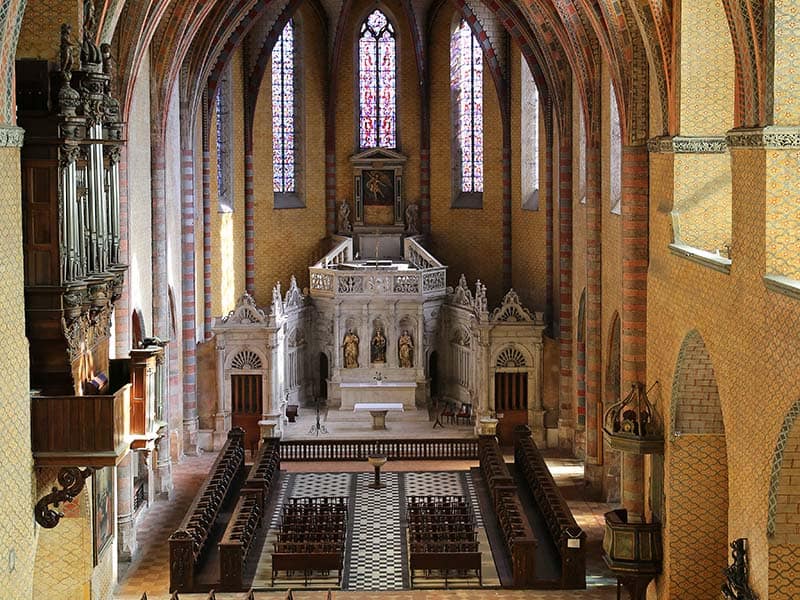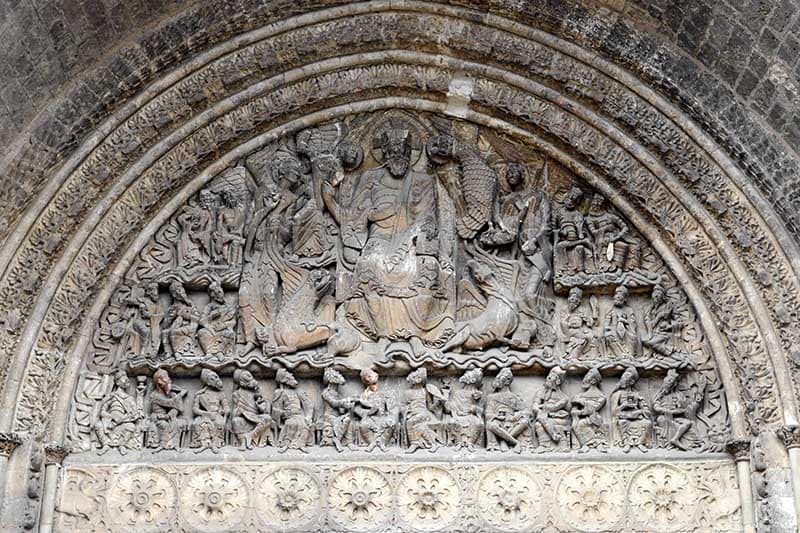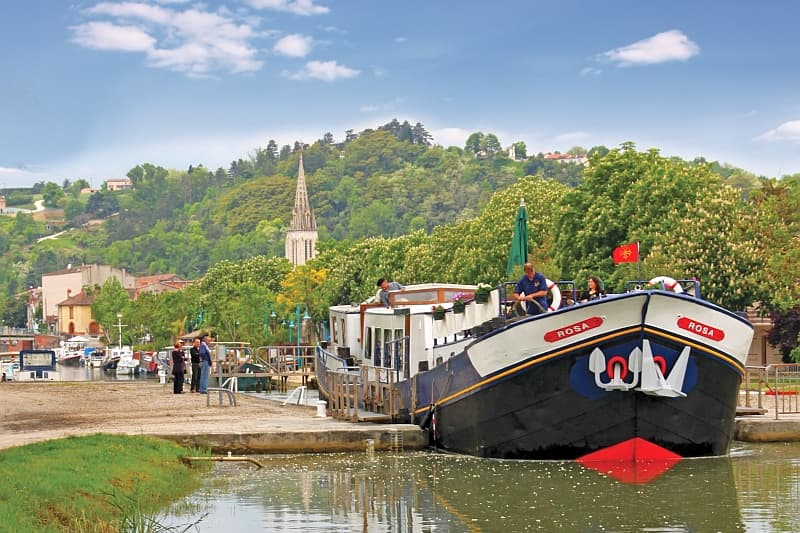An architectural gem in the heart of Southwestern France, the UNESCO-listed Abbaye Saint Pierre de Moissac or Moissac Abbey can be visited on our Spring/Summer cruises aboard luxury hotel barge, Rosa. Find out why this historic seigniory is such a popular experience, not to be missed…
Magnificent Monasteries: Discover Moissac Abbey
Where is Abbaye Saint-Pierre de Moissac?
Abbaye Saint-Pierre de Moissac, or Moissac Abbey, occupies land in the southwest of France near the River Tarn and River Garonne, which leads to the pretty Canal de Garonne – in which Rosa sedately cruises each Spring/Summer. The fertile lands of Moissac are located in the shadows of the historic Quercy vineyards and were formerly on the Christian pilgrimage route to Saint-James of Compostela in Spain.

Why is Abbaye Saint-Pierre de Moissac important?
Abbaye Saint-Pierre was a Benedictine monastery that has been recognised as having one of the best-preserved churches in the Moissac region. The Church of Saint-Pierre dates from the early 1100s and is best known for its incredible Romanesque architecture.
The area where Moissac Abbey is built was owned by the Visigoths for many centuries, but after defeating them in 506, King Clovis of France decided to found a monastery there. Legend says that King Clovis vowed to set up a monastery with 1000 monks, in memory of the one thousand soldiers who died in battle against the Visigoths. In order to decide its location, the French King threw a javelin, and where it landed, the Abbaye Saint-Pierre de Moissac was built.
Work on the abbey did not begin until the 7th century under instruction from Saint Didier, the Bishop of Cahors. The building work was repeatedly delayed because of Saint-Pierre de Moissac’s location on the river, which resulted in multiple ransacks from diverse ethnic groups, including Moors, Norsemen, Normans and Hungarians. By the 1000s, the poorly-maintained abbey was looking dilapidated and in need of care. In 1030, the roof collapsed and then a fire devastated more of the original buildings.
Later in the same century, a new abbot was appointed to put things in order and restore authority over the monks, who were blamed for Moissac abbey’s state of disrepair. Faith in Abbaye Saint-Pierre de Moissac was returned, and the monks were honoured with a visit from Pope Urban in 1097. On his visit, the Pope consecrated the high altar of Saint Pierre Church and brought a further fifty churches under the jurisdiction of the abbot. The Pope also ordered the construction of Saint Pierre Abbey’s cloisters, which can still be seen today.
During the 11th and 12th centuries, the abbey prospered under a golden age. Abbaye St-Pierre de Moissac’s location on the way to Compostela in Spain meant that it became a destination for pilgrims passing through the region on their way to Saint-James. During this fruitful time of its history, the abbey and its church received a great amount of investment.
The Cluniac reforms cemented Moissac Abbey’s position as one of the most powerful religious houses in France. Cluniac monasteries agreed to follow new reforms determining that an abbey’s main purpose was to care for the poor and inspire art. When the Cluniac system was drawn up, the Abbaye Saint-Pierre de Moissac occupied a principal position of importance amongst the monasteries, second only to the Abbey of Cluny.
Benedictine monks left the abbey in 1626 when the decision was taken to secularise the monastery, thus somewhat distancing Abbaye Saint-Pierre de Moissac from its religious values. Under the leadership of powerful abbots such as Cardinals Mazarin and de Brienne, the abbey premises were taken over by Augustinian monks. However, when the French Revolution spread throughout the country in 1793, Moissac abbey was abandoned as a religious house.
Recognised as significant to the history of France, Christian pilgrimage routes and for its Romanesque architecture, Abbaye de Saint-Pierre de Moissac was listed as a UNESCO World Heritage Site in 1998.

What can be seen at Abbaye Saint-Pierre de Moissac?
Abbaye Saint-Pierre de Moissac’s position on the pilgrim road and its position as the second-highest Cluniac monastery in the West meant that it received investment from the papacy. During the medieval period, its buildings were lovingly restored in the Romanesque style of architecture which was popular at the time. Today, the abbey church and cloisters can be seen relatively intact, though some of the abbey complex was demolished in the nineteenth century to make way for a railway track.
Moissac Abbey is best known for its stunning architecture and sculpture. Its beautiful cloisters feature dozens of pillars, topped with decorative 11th century sculpture representing creation and harmony. Observant visitors will see birds, palm leaves, rosettes and foliage carved into the tops of the pillars.
The medieval improvements to Moissac Abbey also saw work undertaken on Saint-Pierre’s Church. St-Pierre Church opens into the town square of Moissac and features colourful fifteenth century ribbed vaults in the Gothic style. Rare Romanesque wooden sculptures of the Virgin of pity, and Entombment of Christ are also not to be missed.

Most famous however, is Saint Pierre Church’s famous portal entrance and tympanum which date back to the eleventh century. The tympanum is beautifully sculpted to represent the apocalypse, which features in the biblical Book of Revelation. Christ appears enthroned at the centre of the scene, presiding over judgement day. He is surrounded by animals, demons, and other imagined medieval creatures.

A sculpture of the Prophet Jeremiah that appears in the abbey church of Moissac is one of the most significant Romanesque sculptures still existing in the Western world. It is thought that some of the most prominent medieval sculptors worked on the carvings at Saint-Pierre de Moissac because of the exquisite expression on the sculpture. The statue of the Prophet Jeremiah is so significant, that it has been compared to sculpture at the famous Domingo de Silos in Spain.

Barge the Canal de Garonne
Join luxury hotel barge Rosa on a cruise along the picturesque Canal de Garonne in Spring or Summer, to enjoy beautiful French landscapes featuring vineyards and historic landmarks. Visit Abbaye Saint-Pierre de Moissac for a private tour and savour lunch with views of the abbey’s entrance at the on-site restaurant, ‘Le Florentin’.
For more information on our cruises in Gascony, or our entire collection of luxury hotel barge cruises, why not order a free copy of our brochure or speak to a member of our team via our handy Contact Form

 English
English
 Spanish
Spanish French
French German
German Norwegian
Norwegian Portuguese
Portuguese Swedish
Swedish Italian
Italian Russian
Russian Simplified Chinese
Simplified Chinese Japanese
Japanese